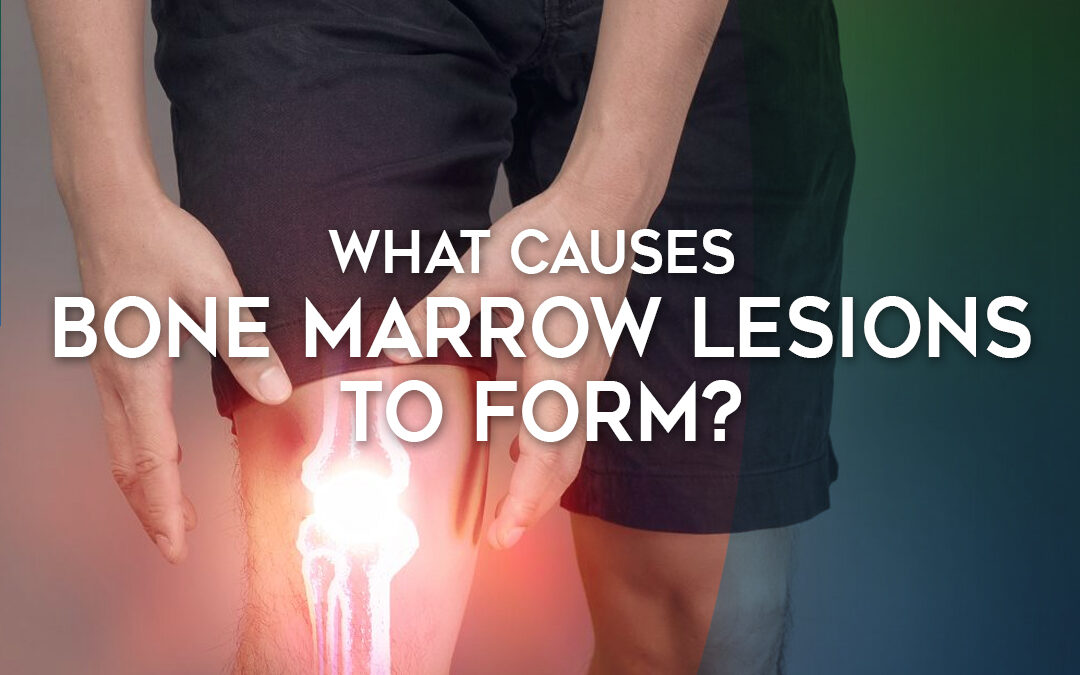A bone marrow lesion (BML) is an area of weak, damaged subchondral bone underneath a joint surface. While BMLs are most commonly found in the knees and hips, they can develop in any joint in the body.
What’s significant about bone marrow lesions? In many cases, BMLs are found in the setting of musculoskeletal conditions like arthritis and bone fractures and are linked to pain, cartilage loss, and joint degeneration. Keep reading to learn more about bone marrow lesions and what causes them to develop.
What Causes Bone Marrow Lesions?
Bone marrow lesions have been discovered in the setting of traumatic, degenerative, inflammatory, metabolic, and neoplastic conditions. Some common conditions that lead to the development of BMLs include:
- Stress fractures
- Insufficiency fractures
- Traumatic injuries (bone bruises and contusions, plantar fasciitis, tendinitis)
- Osteochondral defects
- Osteoarthritis
- Inflammatory arthritis (rheumatoid arthritis, ankylosing spondylitis)
- Bone infections (osteomyelitis, sepsis)
- Cancer/tumors
Additionally, some bone marrow lesions may be caused by undergoing medical treatments like surgery, radiation, and chemotherapy.
The Significance of Bone Marrow Lesions
Bone marrow lesions are a common clinical finding in the setting of osteoarthritis. The available research demonstrates a link between BMLs and increased joint pain, decreased joint function, increased cartilage loss, bone cyst formation, and accelerated disease progression in patients with osteoarthritis.
Currently, bone marrow lesions are an overlooked and underdiagnosed problem in arthritis cases. Traditional arthritis treatment methods — like medications, injections, and exercise — focus solely on reducing joint symptoms and slowing cartilage loss. But failing to diagnose and treat the underlying bone pathologies leaves patients with continued pain, loss of function, and joint degeneration.
Treatment Options
Currently, there is no standard course of treatment for BMLs. The following methods have been used with varying levels of success.
- Conservative therapies. Non-surgical treatments like medications, extracorporeal shock wave therapy (ESWT), offloading, and physical therapy may be able to reduce pain and symptoms associated with bone marrow lesions. However, conservative therapies have limited success at reducing the size of BMLs.
- Core decompression. Core decompression is a surgical procedure that involves drilling several holes near damaged bone to promote increased blood flow and healing to the area. Further research is required to determine the long-term efficacy of core decompression.
- Total joint replacement. Total joint replacement surgery is the final treatment option for patients with severe arthritis and joint damage. However, total joint replacement has many drawbacks — it’s costly, has a long recovery and rehabilitation period, and is not always effective.
At iO-Core™, we’re revolutionizing the arthritis treatment process with the iO-Core™ procedure. The iO-Core™ procedure targets the underlying bone marrow lesions responsible for increased pain and the accelerated progression of joint damage in patients with advanced arthritis. The procedure is performed by a board-certified doctor trained in the iO-Core™ treatment technique.
The iO-Core™ procedure is minimally invasive, requires no hardware implants, and has minimal to no downtime following surgery.
Are BMLs Preventable?
While there are no specific measures to prevent the formation of bone marrow lesions, there are steps you can take at home to preserve your bone and joint strength and mobility, reduce the risk of injury, and slow the progression of joint damage.
- Exercise. Regular exercise keeps your bones, joints, and muscles strong and flexible. Combine joint-friendly, low-impact exercises like walking, swimming, and cycling with a strength training regimen and daily stretching to get a good workout.
- Eat a healthy diet. Eat a healthy diet full of fresh fruits and vegetables, lean protein, whole grains, healthy fats, and minerals like calcium and vitamin D to maintain your joint and bone health.
- Lose excess weight. Extra pounds place extra stress on your joints. If you’re carrying around extra weight, work toward a weight loss plan that gets you into a healthy, stable range.
- Practice good posture. Protect your joints by practicing good posture and proper body form while standing, sitting, walking, exercising, and sleeping.
Find Out If You’re a Candidate for the iO-Core™ Procedure
Many people who were told they needed a total joint replacement surgery have found long-term pain relief and greater mobility from iO-Core™ instead. Contact our team today to learn more and see if you qualify.

